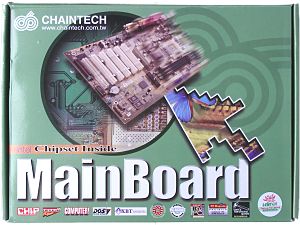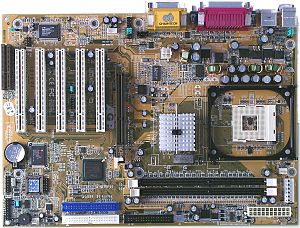
The design of the package has changed - maybe it will make mainboards
also better as they don't show brilliant performance these days. Let's
look at this sample.
Accessories:
- Package: a new design;
- Documentation: a user manual in English, a sticker with brief description
of functional connectors and switches;
- Cables: 1 ATA66/100, and 1 FDD;
- 2 CD with software including:
- drivers;
- user manual in PDF;
- Adobe Acrobat Reader;
- Adobe Active Share;
- Norton Antivirus 2001;
- Appio;
- AutoSave;
- eWalla;
- ImageMore;
- Xstop.

The layout is not the best: IDE connectors are behind the PCI slots,
and they can be difficult to reach if full-size expansion slots are installed.
The AGP connector has a clip which prevents video cards from falling out.
It's not difficult to reach switches and jumpers.
The 3-channel switching voltage regulator incorporates 11 capacitors
of 1500 uF.
The following controllers are integrated: C-Media CMI8738/PCI-6ch-MX
audio one supporting a 5.1 acoustic system. There are connectors for front
audio-outs and for a bracket with an output for the Bass/Center channel.
The ITE I/O controller (IT8708F-A) provides for a smart card reader.
The board supports Lenten Instant Recovery technology and displaying
of POST codes, though the latter seems to be useless because if problems
occur before information is displayed on the monitor we won't be able to
find out what are they caused by.
Non-unsoldered connectors: an audio codec chip (it replaces an C-Media's
audio controller on other boards) and an SPDIF connector supported by the
C-Media chip.
The system monitoring is supported by the ITE IT8712F-A chip. Voltage
of the processor (+/-3.3, +/-5 and +/-12 V) and of the battery, speed of
2 fans and temperatures of the processor (a built-in sensor) and
the board (a built-in sensor) can be controlled. There are 2 connectors
for adjustable connection of fans.
Brief characteristics of the board: memory slots - 2 DDR SDRAM;
expansion slots - AGP/ 5 PCI/ CNR; I/O ports - 2 COM/ LPT/ 2 PS/2/ 4 USB
1.1; dimensions - 305x245 mm.
Adjustment can be carried out with:
| jumpers and switches |
Jumper to clear up the CMOS |
 |
| Jumper to change a CPU frequency |
100/133 MHz |
| Jumper to make possible to start
up a computer with a PS/2 keyboard |
 |
| Jumper to make possible to start
up a computer with a USB mouse/keyboard |
 |
| Jumper to enable/disable an audio
controller |
 |
| BIOS based on v6.00PG from Award |
Setup of memory timings |
+ |
CAS Latency, Active to Precharge Delay, RAS
to CAS Delay, RAS Precharge |
| Setup of memory frequency |
+ |
DDR200/DDR266 |
| Setup of AGP bus |
+ |
 |
| Setup of PCI bus |
- |
 |
| Changeable scaler of AGP and PCI buses |
- |
 |
| Manual assignment of interrupts |
- |
 |
| Changeable FSB frequency |
+ |
In 1 MHz increments, 100-166 MHz |
| Changeable CPU multiplier |
+ |
x8-x50 |
| Changeable core voltage |
- |
 |
| Changeable memory voltage |
- |
 |
| Changeable chipset voltage |
- |
 |
| Changeable AGP bus voltage |
- |
 |
We used the latest available version of the BIOS - 17/12/2001.
The board shows quite good speed results. I wish it also had more functional
capabilities and settings - I hope the engineers will take it into account.
Test results:
Write a comment below. No registration needed!


